Last week, Portland bonsai professional Michael Hagedorn participated in an AMA (Ask Me Anything) at Ask Bonsai Tonight. His responses shed light on topics ranging from fertilizer to pots to cuttings to his favorite food (not natto).
Some questions touched on Michael’s involvement with the Portland Bonsai Village. Two years ago, Michael formed the Village with the aim of promoting and supporting bonsai arts in and around Portland. The Village also offers tours of local bonsai nurseries.
As these tours will be available to visitors attending this fall’s Artisans Cup, the two events are often mentioned together. Organizationally, the two projects are independent endeavors – Michael manages the Village and Ryan Neil heads up the Artisans Cup. Together, the coordination makes this fall an awesome time to visit Oregon!
I’m so excited about these events that I traveled up to Portland last weekend with Eric Schrader to check everything out ahead of time. That, however, can wait until next week. Here follows a lightly edited transcript of the AMA – you can find the original thread at Ask Bonsai Tonight.
Q: Just in the last few years it seems as info on development and refinement of Pondo pines has really evolved. I am somewhat confused though – even after working with Ryan with a study group. Its clear that leaving buds and needles alone and increasing growth as much as possible through all season aggressive fert and pumice based soil really gets them rocking however my understanding of the refinement phase is less clear especially on techiques and timing of cutting hardened candles – can you give a Pondo refinement sysnopsis with your usual lucid eloquence.
– Crust
A: Ponderosa is a great subject. The main thing to recognize is that the big main bud at the end sets up everything that the tree does. It doesn’t naturally WANT to backbud. But unlike a black pine, we can’t force it to do that, we can only suggest. So, grow your tree strongly, then if you have some really long massive buds, you can pinch them in half or cut them when it’s partly hardened. I don’t fully cut off any candle on Ponderosa. Then in the late summer, cut some of the old needles off around the strongest shoots, and don’t cut any around the smaller shoots. Over about five years, this simple technique will create some backbudding, not a lot, but it will even up all the buds. Also, all of these techniques work best if you’ve actually brought your branches down with wire, styled your tree. Lower that big bud, and it loses a lot of its power over limiting backbudding. It will take some years, but they do even up and ramify. And GREAT sun, very necessary!
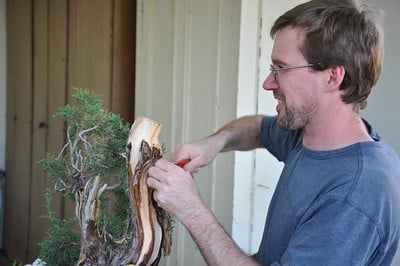
Michael Hagedorn
Q: What is key in developing and maintaining good shohin bonsai?
– Stefan
A: Shohin are such a miniature world that the techniques we use should also be funneled down. What we can do in inches on normal trees we need to do in fragments of an inch. If you’re wiring, make your spirals closer. If you cut, cut closer. If fertilizing, wait until growth has hardened off in late spring to begin or internodes will be long.
Q: Do you tend to feed your companion plants? If yes, with what and how often? If no, what is the rationale behind the decision?
– Stefan
A: Yes, I feed companions. In late spring, or after flowering. Don’t overfertilize.
Q: Any new “hidden” species in store for us, similar to chojubai?
– Stefan
A: I think our local natives are our treasures, explore them and apply our known techniques to new species. By natives I don’t mean halfway across the country, but what grows on the nearest hill. Explore those!
Q: Tips or pointers on ramification of virginia creepers?
– Stefan
A: Creeper is a vine, so like any vine it loves lots of water and fertilizer. Pump it up, let it run, then when they are hardening off cut back hard, you can even try defoliating. The regrowth will be your ramification.
Q: What are your favorite trees to work on?
– Rory
A: I love so many, whatever tree I’m working on… but, I do particularly enjoy Chojubai, Pine, Maple, Hemlock, and Spruce.
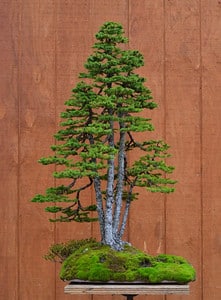
Ezo spruce – photo courtesy Michael Hagedorn
Q: What is your favorite food? hope it’s not something like tofu.
– Rory
A: Food? good heavens. Not natto. Salad. I like salad.
Q: No natto? You don’t want to live forever?
-Rory
A: I’ll opt for a lot less than forever if I can avoid natto!
Q: As a highly skilled potter who or what kiln do your favorite pots come from?
– Rory
A: The best bonsai pots still came from the Chinese 150-300 years ago.
Q: Do you go on collecting adventures?
– Rory
A: I do collect, but I also enjoy starting something from nothing.
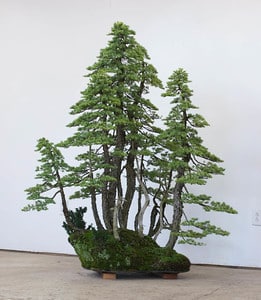
Hemlock – photo courtesy Michael Hagedorn
Q: Do you sell bonsai trees?
– Rory
A: I sell to students occasionally.
Q: What advice can you give to a person with less than 3 years learning bonsai?
– Rory
A: Invest in yourself! Find a teacher, and then, try trusting that person for a while. Try to avoid bobbling from one teacher to another initially. Later you can study with others. A teacher is more valuable than a book or a blog (both Jonas and I write blogs so I feel safe saying that.)
Q: I love your work! I was wondering if you could give some suggestions on how to keep red spider mites at bay! With the unusually warm spring here in California this year they are hammering my junipers.
– Ryan
A: Spider mites! Neem oil will do it, also Bayer Advanced will take care of them, or, both at the same time. A miticide will set you back hundreds, yet will do the job.
Q: Oh and have you given any thought to publishing an ebook version of your ‘Post-Dated’ book through Amazon? I know that doesn’t get rid of the plethora of copies you have in your spare bedroom but I would love to read it!
– Ryan
A: I have thought of an ebook, but haven’t tried that yet. There’s a Spanish edition that will be coming out in ebook form.
Q: In your book Post Dated, all the trees pictures are truly spectacular and each one is very special. I do however keep coming back to the Shimpaku pictured on pg. 96. That one in particular is one of my all-time favorites. I was just wondering if there is any info, or maybe a story or something that you might be willing to share about that one?
– Jeremiah
A: Suzuki was very fond of that tree, his favorite juniper. He said it reminded him of a tree that many years ago was put on a revolving display stand because it had so many good viewing points.
Q: Do you use any tools for Bonsai that are considered non-traditional, if so what are they and what do you use them for?
– Jeremiah
A: Yes, some zip ties, and some of the nylon and plastic boards for slabs.
Q: What is your vision for the Artisan Cup in ten and twenty years down the road?
– Jeremiah
A: All the credit for the Cup goes to Ryan Neil, that’s entirely his creation and I’m really looking forward to it. So I don’t know what his plans are for its future. My project is the Portland Bonsai Village. I blog about the Cup because Ryan is one of my Villager colleagues and I love the effort he’s put into it.
Q: I love the native collected material you’ve posted on your site, truly amazing! I’m curious if you have considered growing any native material from seed, cutting or airlayer? If so what type of tree?
– Jeremiah
A: I’ve not tried any cuttings or airlayers from natives, I can collect them so that tends to be more interesting.
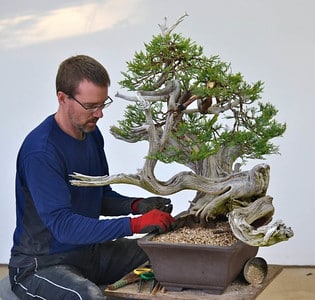
Rocky Mountain juniper – photo courtesy Michael Hagedorn
Q: I plan to attend the Artisan cup this year with my wife, what non-Bonsai related things around Portland would you recommend? What places to eat do you like best?
– Jeremiah
A: Try to see the Columbia Gorge, many beautiful waterfalls. Take a look at The Farm, great farm to table restaurant.
Q: Given your background as a potter do you think it’s ironic that you are now well known for experimenting with different planting compositions and even not using pots.
– Danny
A: Very ironic! Nearly hilarious. But, gotta go where one is led.
Q: What’s next for you after the artisan’s cup?
– Danny
A: Again, the Cup is the dreamchild of my great colleague Ryan Neil, as for me, I’ll continue to encourage people to visit Portland and our Villagers through the year-round programs of the Portland Bonsai Village. Otherwise I’m relatively a happy hermit and hope to do more writing next year, I’ve a book I’ve been working on for a while now and it’s always been punted down the road to make way for things like a website for the Village. Sigh. So, more hermiting next year.
Q: I am interested in your take on the future of non-classic styles. Such as your vine maple imitating growth on a log, the constructed pots of nylon that you have used, or Walter Pall’s fairytale style. How do you see these faring in exhibits and shows? Will they rise above the crowd favorite level? Are there going to be different evaluation criteria used or are the ones in use going to be modified for a fair comparison in judging?
– Zack
A: Well, it’s hard to say, depends much on the acceptance of the community over time and the judges. I’d be surprised if they rose to anything notable, unless over a long time where greater visibility made them more acceptable. Bonsai is a reluctant art. In any avante-guarde offering, rules for judging shift.
Q: Kimura was a revolution in Japanese styling that is now accepted. How long will the western new styles take to be acepted in mainstream bonsai thought?
– Zack
A: It’s hard to say…but because there was a hiccup of time to realize Kimura was doing groundbreaking work that was really viable, there will be likely the same hiccup of time to get used to what is new, elsewhere. As there should be. Not all experiments succeed. And then, Western audiences are likely to accept new work far more fast and readily than they should.
Q: I have a two questions about Japanese White Pines. First question is about pollen cone formation. Is there anything that you know of that causes these to form or anything that can be done to prevent their formation? In some years the formation of large areas of pollen cones can leave branches with long bare necks behind the new needle buds. I have been removing these as early as I can, is that the correct timing?
– Judy
A: Some years there is a big pollen formation, other years nearly none. I think this is climatic, and year by year, not sure what we can do about it. Leave them alone, though, and let them age and fall off. A lot of damage is usually done when we try to remove them young.
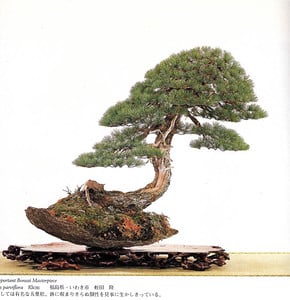
White pine styled by Michael Hagedorn as displayed at Kokufu-ten
Q: My second question is about grafts and Zuisho White Pine. Is it true that the graft will always fail on Zuisho grafted onto JBP stock?
– Judy
A: I’m not aware that all grafts fail on Zuisho, but most Zuisho are on their own roots. Made from cuttings.
Q: My question is about flowering bonsai such as Cotoneaster, Ume, Crabapple, Quince, etc. I have read about not repotting till after they have flowered. Do you adhere to this methodology or repot like other deciduous when dormant?
– Doug
A: I repot all these flowering trees in the spring. Don’t have any problems with flowering. If you’re in a drier, hotter climate I would definitely repot early, in the early spring, otherwise the tree might have trouble recovering with a hot summer right around the bend.
Q: Why are you using vine maple for your moss planting works that you’ve completed recently?
– Eric
A: Vine maple is indigenous to the areas where these nurse log/rotted/mossy undergrowth landscapes that I’m trying to evoke with the moss plantings. Other species I’d like to try are Mountain Hemlock and maybe some of the huckleberries up here in the Northwest.
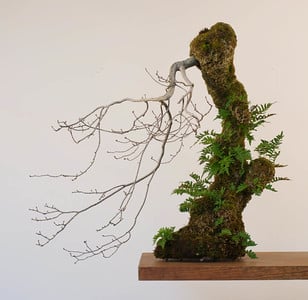
Vine maple – photo courtesy Michael Hagedorn
Q: What do you see in your students’ work that makes you happiest?
– Jonas
A: My favorite thing is seeing the shock of understanding in the eyes of my students when something slips in sideways… otherwise, it’s fun to see them do work that shows enough understanding of technique to bend it a bit and begin to speak with the language of bonsai.
Q: Can you pls tell me what was the hardest part of life in Japan while you were apprenticing. Do you recommend the experience to other Americans?
– Chris
A: Ooooohhhh, well, although the physical part was demanding enough – I did hurt myself a few times including a popped tendon behind my knee – the most challenging was probably the high level of emotional stress that apprentices undergo. And you don’t need to be a foreigner to be subject, the Japanese had it just as hard. There’s no way to be perfect when you aren’t that good yet. Steep hill.
As for Americans apprenticing over there, I really can’t recommend the experience to anyone, it has to be self-recommended. Otherwise I’d surely get some death threats. Apprenticing just isn’t a lot of fun. If you can forgo fun, it might be worthwhile, but really success as an apprentice is more about attitude than ability. That’s maybe the simplest advice I can offer, if anyone were interested in studying abroad.
Q: I have a Douglas Fir that I just styled last fall. It lost some needles in the process this winter, but is in pretty good shape. How do I handle the new growth – do I pinch it back like a spruce now to keep the shape and induce back budding?
– Richard
A: Let it grow out a bit and then you’ll see the buds forming along the shoot, and cut them off to a bud (they will be quite small). That way the tree will benefit from the extension, which will grow roots.
Q: Luis Vallejo’s Japanese Beech has inspired me to start developing my own. When do you cut them back? Are there any special techniques you use? Why do they sometimes develop brown edges on the leaves? What’s the best way to refine a heavy rooted nebari – conservative or aggressive?
– Paul
A: Beech should be cut back in the early spring, just after they lose their leaves, which hang on during the winter. Prune back to 2-3 buds. Remove the last big bud at the very least. Some shoots will only have small buds and for the time being you can leave those longer branches long to gain energy.
Only cutting the leaves in half on the exteriors of the branches in the early summer, after hardening off. This will encourage and strengthen the interior buds and shoots. I don’t use some of the more invasive techniques like cutting off all the leaves a month before dormancy to force buds – I really don’t like forcing trees to do something unless it’s a black pine with a lot of natural energy.
Brown on the edges of the leaves is usually a result of drying out a bit more than they wanted to. Sometimes this is only a few hours on one day during the summer…they are a bit touchy. They love sun, but we need to be careful with their watering.
I don’t like being aggressive with beech. It’s not a naturally powerful tree, so go at a nebari over successive repottings.
Q: I’ve noticed that lower branched buds are much weaker so in terms of energy balancing these lower branches need special treatment. My intuition tells me to cut these back much less and be more aggressive with the top?
– Paul
A: On a refined tree, leave lower branches with weaker buds on them alone, maybe let them grow until fall. Then cut back then. The new growth on the rest of the tree, for a refined tree, may be cut back to 2-3 buds, and later in the year, early summer, the leaves on these outer areas cut in half.
Q: I would like to know how to develop branches on eleagnus (gumi) – especially fine ramification. Grow to how many leaves and then cut back? How often? Timing? My tree is too vigorous. Is it possible I fertilize it too much? Maybe I should not fertilize until the leaves harden up? Defoliation??? How many times a year? Will that help? Currently I cut the leaves like in Japan>>>rhomboids, but never did defoliation apart from removing the very large leaves. I am in Africa. See Progression photos in the comment section.
– Neli
A: I’ve worked on gumi but I hesitate to offer advice on it, as I don’t have enough ‘after-work’ to analyze how they respond. Sorry about that!
For some general comments, though, yes, for a very vigorous tree, you might not want to fertilize so aggressively, and then also you might want to not cut back so hard. Really hard pruning just makes trees like that mad, essentially, and they push out all the stronger. Leave more and they push less. And less fertilizer helps that too.
For many refined bonsai, fertilizing after the leaves have hardened is a common technique to contain the growth better.
Many strong, vigorous deciduous trees and broadleaf evergreens can be defoliated. I’ve tried on many that we don’t work on much in the bonsai world and they flushed out again fine. I’d just read the tree. And experiment on something that isn’t your best tree.
Q: What are your thoughts on twisted and dwarf pomegranate? Any training tips on ramification?
– Sely
A: You can grow pomegranate strongly, and they will respond to cutting back by creating new growth. They are naturally rather strong trees, though.
As for flowering on the dwarf pomegranates, I don’t know anyone who has consistent luck with them. Very reluctant critters!
Q: One question I had was about fertilising flowering bonsai. What is the principle behind NOT fertilising a tree while it is flowering? (I’m a beginner, as you can see) smile When is it OK to use a flower-boosting (high P?) fertiliser on such trees? I’m curious about the timing for those things, especially for the species which have flowers before leafs. Do you see what I mean? I have a flowering plum bonsai and I didn’t know about this rule and fertilised it as “normal” while it was flowering. It seems to be doing fine, still.
Another question I had was about fertilising cuttings. I guess you are going to say that’s a no no? I took various cuttings from some trees around as an experiment, and planted them in a pot. My instinct says not to fertilise, but I’m not sure.
– Marie
A: It is confusing, the advice about not fertilizing a flowering tree while in flower. There are several points to this. The main one is that it assumes that ‘fertilizing’ means high nitrogen, which maybe should be avoided for most flowering plants. But not all. Chojubai is a good example. This tree if anything flowers more when you fertilize it more, even when nitrogen is the highest number of the three macros.
But for most trees that flower before they leaf out, don’t fertilize until after flowering. In general this will be a more established bonsai, and in general we wait a bit before fertilizing them anyhow.
And then, if you want fruit, then that’s where too much nitrogen MIGHT be a problem. But not in all instances, Chojubai again being an exception, since the fruit will develop happily even with a lot of nitrogen present.
And then giving a tree some kind of fertilizer after flowering is a good idea since most kinds of flowering are weakening to a tree. After flowering a modest, balanced fertilizer with roughly equal parts of the macros in a 5-5-5 approximately, will be fine for any tree even if in fruit.
As for cuttings, just be sure it’s rooted before fertilizing. And then when you do, go for something mild, like a bit of fish emulsion. I think it’s important to fertilize a cutting before the fall, because it needs to build up its resources having lost so much growing roots.
Q: When repotting some trees, usually I am thinking pines, I find roots coiling around the bottom of the pot and growing very strong there. In the bulk of the pot there are less roots. Is this a result of my watering habits? I have been told I water not often enough and the roots go to where there is residual water. How does one develop that “loaf” of fine roots on pines?
– Michael
A: Might be the soil mix. The volcanic soils, like a mix of pumice, lava/scoria, and akadama seem to form the best interior root growth that gets better over time, whereas organic mixes or fired clay mixes are a bit hit or miss. Also, when watering pines water REALLY thoroughly, then let dry out a bit. That way you’ll be sure to moisten the interior of the root ball. Check to see if the interior areas stay bone dry. If so, your trees will appear to dry out terrifically fast. Soak your pots in that case from the bottom up to restart penetration from above into the interiors.
Subscribe to Bonsai Tonight
New Posts Delivered Every Tuesday and Friday